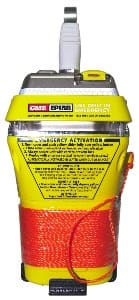With the introduction of the 406 Mhz emergency position indicating radio beacon (EPIRB) standard in the 1990s, the benefits of satellite rescue took a tremendous leap forward. The 406 standard required that EPIRB transmitters adhere to tight frequency stability rules. The result is faster and more accurate position determination for the mariner in distress. Voyagers have equipped themselves with 406 EPIRBs and phased out older 121.5 Mhz models. As a result of COSPAS/SARSAT (COSPAS is a Russian acronym for search and rescue satellite system), offshore safety has come a long way from the days of flare pistols and signal mirrors.
In the short term, EPIRB manufacturers have made all the big technological improvements. Now they are working on different approaches to increase their beacons’ feature set and improve beacon servicing. In the long run, a whole new approach to processing 406 Mhz alert signals is on the way. An approach that promises to decrease response times and improve beacon accuracy even further.
One new player to the North American EPIRB market is an Australian company called GME, which has recently introduced its 403 series of 406 units into the North American market. What’s intriguing about these models is the way GME handles battery replacement. With other EPIRBs, you give your unit to the manufacturer or dealer, they replace the battery and return the unit to you. Often EPIRBs will get banged around a bit and look a bit worse for wear. GME has decided on a different approach. It has designed its 406 unit around an easily-removable PC board. On the board are all the electronics modules: the 406 Mhz oscillator and transmitter circuits, the GPS receiver, a helical GPS antenna, test circuits, and the memory chip that holds the EPIRB’s registration data (remember to register your EPIRB!) like owner’s name, contact information, boat name, description, home port, etc. Thus, when you return your GME 403 for battery replacement after five years, GME’s authorized dealer will open the case, slide out the PC board with your registration info intact, slide it into a new case with new batteries, a new 406 antenna and lanyard and return it to you.
According to George Lariviere of GME, it will be like getting a new EPIRB for the price of a battery replacement (about $200). “GME will put the PC board of an older unit into a new package, with a new antenna,” said Lariviere. In some ways it might be better than getting a new EPIRB, since users will not need to register or reprogram their personal data. In addition, voyagers will have a new case that tells them with a glance that the battery has been properly serviced.
Other EPIRB manufacturers are also adding features and capabilities to their units. ACR Electronics’ GlobalFix iPro 406 unit, for example, is equipped with a feature it calls “dual GPS technology.” Not only does the EPIRB carry its own GPS receiver, but you can connect GlobalFix iPro EPIRB to your vessel’s GPS and the unit can store the latest GPS position in memory. This allows your vessel’s coordinates to be included in the EPIRB’s first data transmission. There’s no delay while a cold starting GPS acquires the satellites and calculates its position.
The present COSPAS
SARSAT setup is very good, but it still has its weak points. The present system uses polar-orbiting low earth orbit (LEO) weather satellites and geostationary earth orbit (GEO) communications satellites. While the GEO satellites can immediately pick up a 406 Mhz distress signal, they cannot determine the position of the beacon using Doppler shift (if the EPRIB is GPS-equipped, then the GPS-derived position is included in the distress message and COSPAS/SARSAT watchstanders would then have an idea of the position of the beacon, if the beacon is not GPS equipped the only way to determine position is via the Doppler shift of the received signal as the satellite passes by). In the present system, watchstanders must wait for a LEO polar-orbiting weather satellite to get a Doppler profile to determine position. Sometimes this can mean waits of up to an hour before a LEO satellite is in the right orbit to pick up the EPIRB signal.
A better approach would be to use a constellation of medium earth orbit (MEO) satellites to receive EPIRB signals and retransmit them to the ground for Doppler shift analysis. With a 24 to 27-satellite constellation, several satellites would be able to instantaneously receive EPIRB distress signals from just about anywhere on earth. Such a system would eliminate waiting times for polar-orbiting LEOs to pass over a distress-signaling EPIRB.
Happily, there is no need to launch 24 MEO satellites to establish such a constellation, because this arrangement already exists: the GPS system. There are 24 operational GPS satellites (and several in-orbit spares) already in position. In this new approach, called distress alerting satellite system (DASS), GPS satellites will carry 406 Mhz transponders. No less than four satellites will be in view at all times. Should you send a distress message, the 406 Mhz transponders on four GPS satellites will pick up the signal immediately and transmit it down to an earth station. There will be no more waiting for a polar-orbiting LEO to get in the right orbit to receive your EPIRB signal in order to get a Doppler shift profile. This will shorten the elapsed time for mariners in distress and will reduce costs by making search areas smaller.
Right there are Block IIR GPS satellites carrying 406 transponders during DASS’s proof of concept testing stage. The plan is for all the future Block III GPS satellites to be equipped with 406 Mhz transponders for use in the DASS program.

